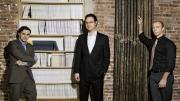“Sex sells.” Now sex cells sell, too. In 2004 more than a million infertile Americans paid dearly to conceive a child. Although sperm (in high supply) is a bargain at $250 to $400 a vial, the price of eggs (harder to come by) is $3,000 to $8,000 per cycle, for one to 10 eggs. Conception can cost $3,000 for ICSI (intracytoplasmic sperm injection into the ovum) or up to $14,000 for a cycle of IVF (in vitro fertilization). Need to rent a womb? Gestational surrogates are $30,000 to $120,000. No wonder revenues for the U.S. fertility industry nearly hit $3 billion in 2004. As Spangler professor of business administration Debora Spar argues, producing babies for those who can’t has grown from miracle medicine to global business: “the baby trade.”
“When people want children and can’t have them, the demand is probably deeper and stronger than anything else,” she says. Infertility, “a permanent aspect of the human condition,” affects 10 to 15 percent of any population, but for centuries there’s been no “supply” to meet demand except orphans, she explains. Then, in 1978, the first “test tube baby” was born. Assisted reproductive technology (ART) “provided us with the supply. And if you have demand and suddenly you have supply, they will meet in a market, and that’s exactly what’s happening.”
Infertility can be tragic personally, butas Spar wrote in her recent book, The Baby Business: How Money, Science, and Politics Drive the Commerce of Conception (HBS Press)it’s “exceedingly attractive” commercially. The widely varying success rates in “manufacturing embryos” (as one doctor calls it) also means repeat treatments. “People have no idea what the costs are going to be, because they don’t understand what the probabilities are,” Spar explains. And because there’s little U.S. government oversight, there’s no formal consumer protection.
“Fertility is just a Wild West,” she notes. “There is no regulatory system.” Take price. Massachusetts health insurance covers up to seven cycles of IVF, about $100,000, but New York insurance doesn’t. “You shouldn’t have that much price variation between states in what is essentially the same commodity,” says Spar. “All fruit costs roughly the same amount, but all healthy babies don’t.”
Baby shopping, of course, isn’t the same as car shopping. “People rarely say, ‘Gee, I would like to be a parent. What are the various routes by which I can become a parent, and how do they compare against each other?’” says Spar. Economists would say we don’t think in terms of “substitute goods.” As a society we treat ART, adoption, and “good old-fashioned sex” completely differently. Sex, or having a baby from sex, is “one of the few things that we cover almost entirely through health-insurance subsidies,” notes Spar, at $7,000 to $12,000 per delivery, whereas adoption and fertility medicine are generally paid out of pocket. “But if I had really paid the price it cost me to deliver my two boys the old-fashioned way, it would have cost as much as adopting my daughter.”
The market segments for sperm and eggs also function differently. “It’s very easy to donate sperm and very difficult to donate eggs, so you would expect eggs to be more expensive,” says Spar. “What’s intriguing is how differently we treat eggs.” Eggs are sold with pictures and personal profiles, while sperm is sold by basic genetic characteristics. Because there are genes for hair color and height but not for piano playing and volleyball, notes Spar, “there shouldn’t be a premium for Harvard eggs, [which have gone for] $35,000 or $50,000. Harvard sperm does not get a premium!”
The most complicated segment of the market is surrogacy, which Spar says used to mean purchasing “a ‘bundle’ of eggs plus pregnancy and a womb.” For a price, a woman agreed to be inseminated by a man and bear his child. Because the surrogate was the genetic and birth mother both, the procedure led to a few “horrific” custody fights, such as the infamous Baby M case of 1985, and people shied away. But IVF solved this problem. “Instead of buying the bundle, you can now buy the eggs from one source and the womb from another,” Spar explains. The surrogate is no longer the genetic mother, so “people presume that her links to the child are diminished.” This has opened up the surrogacy marketwith interesting results. Commercially, consumers “want different things from their eggs than they want from their wombs. They want their wombs to not smoke, not drink, and just behave and carry a healthy baby, which many women can do. But they want their eggs to have particular genetic characteristics.” That meant the “price of wombs actually stabilized, and the price of eggs went up.”
Spar hopes her work empowers people to enter the baby market not as victims of infertility, but as consumers with options. “People don’t want to think of themselves as being in a commercial relationship, so they don’t think in terms of substitutes,” says Spar, but sex, ART, and adoption aren’t all that different. Yet she also worries about encouraging a consumer mentality. “There is the risk that people will behave too much like consumers and say, ‘Well gee, I’m paying all this money, why can’t you guarantee me a child?’ Because it’s not a market in that sense, that anyone can promise a child.”
~Harbour Fraser Hodder
Debora Spar e-mail address: dspar@hbs.edu






